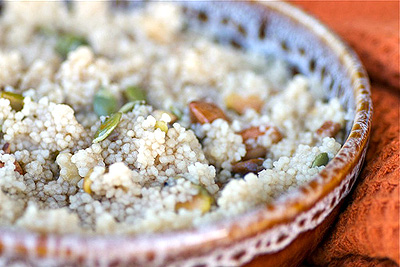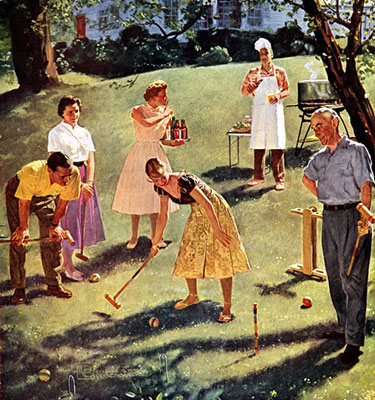 I blame my mom. Growing up eating her hearty Italian pasta dinners has made nearly all other grains seem insubstantial. Rice is good, but you have to eat more of it to get full. Wheatberries are filling, but they take too long to cook. Couscous is, well, wimpy. That's right, couscous is wimpy. How can anyone get full on a dinner of delicate, fluffy couscous? I can't. That's why I have relegated it to breakfast.
I blame my mom. Growing up eating her hearty Italian pasta dinners has made nearly all other grains seem insubstantial. Rice is good, but you have to eat more of it to get full. Wheatberries are filling, but they take too long to cook. Couscous is, well, wimpy. That's right, couscous is wimpy. How can anyone get full on a dinner of delicate, fluffy couscous? I can't. That's why I have relegated it to breakfast.
For breakfast, couscous works. It's a welcome change from oatmeal and is just as versatile. It can be made with water or milk and tastes great with add-ins like nuts, dried fruits, or fresh berries. Of course, a drizzle of melted butter, maple syrup, or honey only makes it better.
This Warm and Nutty Breakfast Couscous is packed with belly-filling good carbs and lean protein. It's crunchy, chewy, sweet, and filling. It's definitely not wimpy.
Food, Family and Memory
Food, Family, and Memory
Thank You and Happy Birthday, Lucy Dahl!
 My sister and I have a pretty terrific food store called The Green Spot we have owned or more accurately been the worker bees at for many years., It has an energy all it's own. It’s a gathering place for people to come to when they are happy and it is a place people run to when they need good solid honest advice of the non-food type, if you know what I mean.
My sister and I have a pretty terrific food store called The Green Spot we have owned or more accurately been the worker bees at for many years., It has an energy all it's own. It’s a gathering place for people to come to when they are happy and it is a place people run to when they need good solid honest advice of the non-food type, if you know what I mean.
Each day we never know what will unfold when it is time to open the doors at nine o'clock. One thing, or well maybe two things, that we do know is that it is sure to be interesting without question and second what every figurative ‘fire’ needs is dousing. And we surely know how to do that with grace.
A few years ago Lucy Dahl who summered on a lake not too far from our store said that her Mother was coming to visit for a long weekend and she was excited to introduce us. Like anyone expecting company we wanted our store to be perfect because Patricia Neal was coming to visit. Oh my, Patricia! How proud our mother would have been because she admired her tenacity and talent so much. Patricia Neal was coming to our food store in a little town in central Maine. I was humbled and speechless!
Weather Wars
 My dad is a competitive person, especially when it comes to the weather in wintertime. He'll call me from Rhode Island and say, "What's the weather like in San Diego?"
My dad is a competitive person, especially when it comes to the weather in wintertime. He'll call me from Rhode Island and say, "What's the weather like in San Diego?"
I tell him what I always tell him: "Oh, it's the same. Sunny and 70s."
Then, invariably, he'll say something along the lines of, "Yeah, it's was beautiful today in Rhode Island too. It was 44 degrees. It was so warm I had to take my jacket off."
Poor guy. Doesn't he know he just can't win the weather war? Search "best weather in the world," and San Diego always makes the list, along with other celestial destinations such as The Canary Islands and Cabos San Lucas. Consider this: In January 2011 Rhode Island earned the dubious distinction of "3rd Snowiest January in History." In San Diego, you can expect sunny skies and high 60s pretty much every day.
Party at the Sofitel

Yesterday was the end of almost a years worth of planning and preparing for our youngest daughter Hannah’s Bat Mitzvah.
She did beautifully; you’re so sweet to ask. My husband Chad and I can never seem to do things simply. For instance, when the kids were small, we always did theme parties. One year, we did The Westwood Minster Dog Show for our oldest daughter Lena’s 10th birthday. Her friends brought their dogs and if they didn’t have one, they were judges deciding who would get the ribbon for:
1) The laziest
2) The cutest
3) Best licker
4) Best at not obeying commands
You get the idea. Each ribbon had these things printed on them. We made an obstacle course for the dogs using the kid’s old toys: an inflatable pool, a collapsible tunnel, a suspended tire etc.
Remembering Zoe Alice
 Whether you like FaceBook or not, it has its' merits. People and relatives are easier to find.
Whether you like FaceBook or not, it has its' merits. People and relatives are easier to find.
Last week a woman left me a message and a friend request. I hesitated. I had no idea from her picture who this person was and why she was ‘friending’ me. Curious, I opened up her profile. This dark haired, beautiful woman was my second cousin.
After the surprise of finding a new family member, I explored her profile to find out about her, as I hadn’t seen her in 50 years. She still lived in Florida, the last place that I had visited with her and her family but this time she was all grown up.
Brenda is her name, just like mine. Odd that we share the same name and she is older by barely a month. We messaged back and forth that evening and I liked her. Then she announced that she was coming to Maine 3 days later to see the foliage with her husband. I invited them to dinner and to stay at my house. She declined but agreed to visit us at our store. The common thread we shared was my aunt Alice, my mother’s aunt and her grandmother.
I felt compelled to tell her some obscure piece of information so she had no doubt that I was truly the correct Brenda. I don’t know why. I said if she stayed overnight I would make pineapple schnecken, for breakfast just like aunt Alice always made for me. She knew I was ‘the’ Brenda that she was looking for. I knew exactly how to make the schnecken because I had saved the recipe in a special place for 50 years in my heart.
More Articles ...
Welcome to the new One for the Table ...
Our Home Page will be different each time you arrive.
We're sure you'll find something to pique your interest...


